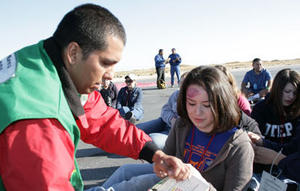TrendIn era of tighter budget, simulation-based training becomes popular
Training is invaluable, but first responder and emergency management agencies around the country are finding their budgets tighter than ever, and it is becoming increasingly difficult to conduct large-scale training exercises; the solution: simulation-based training

Mock disaster response exercise at University of Texas - El Paso // Source: utep.edu
Training is invaluable, but first responder and emergency management agencies around the country are finding their budgets tighter than ever, and it is becoming increasingly difficult to conduct large-scale training exercises. The federal government is considering scaling back 2011’s National Level Exercise, which was envisioned as a 5-day drill in response to a magnitude 7.7 earthquake in the Midwest. Live drills also are becoming harder to produce on the state and local level, as funding is difficult to come by.
Government Technology’s Elaine Pittman writes that, as a result, simulation-based training has become a popular and cost-effective method of training personnel, and agencies across the country are employing software and tools to aid their education efforts.
“Simulation is a valuable tool for emergency response and can be used for vulnerability assessment, planning, training and decision support,” wrote Dale Hall, former director of the National Institute of Standards and Technology’s (NIST) Manufacturing Engineering Laboratory, in the report “Modeling and Simulation for Emergency Response.” “It was identified as the only feasible approach when it is difficult to do real-life experiments, as is the case for homeland security applications.”
Pittman notes that simulation-based training is as diverse as the events the nation’s responders face; it can be used to drill on emergencies related to public health, hazardous materials, natural disasters, homeland security issues, and to test incident command and emergency operations centers. Training also can range from simulating emergency events for a single user to a multiuser, multiagency environment.
The New York City Office of Emergency Management (OEM) drills its first responders and partner agencies in a 3-D virtual replica of the city. City blocks are scaled to size, citizens roam the streets and Macy’s sits prominently on 34th Street, as officials conduct a disaster simulation to test the agency’s unified command. The OEM worked with Environmental Tectonics Corp. to create the virtual environment that runs on the company’s Advanced Disaster Management Simulator (ADMS) training system.
You may go to Emergency Management to learn more about the OEM’s use of simulation software.
